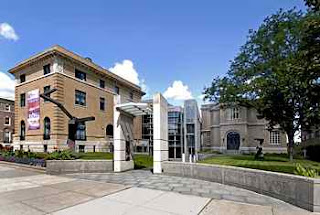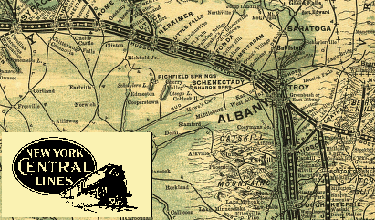 The following is a listing of current and upcoming exhibitions appearing at the Albany Institute of History & Art from January through May 2011. Dates, times, and details are subject to change. Call (518) 463-4478 or visit www.albanyinstitute.org for more information.
The following is a listing of current and upcoming exhibitions appearing at the Albany Institute of History & Art from January through May 2011. Dates, times, and details are subject to change. Call (518) 463-4478 or visit www.albanyinstitute.org for more information.
Current Exhibits
OLD SOLES: THREE CENTURIES OF SHOES FROM THE ALBANY INSTITUTE OF HISTORY & ART’S COLLECTION (THROUGH APRIL 3, 2011)
Highlighting the museum’s shoe collection, Old Soles includes an amazing variety of shoes and pattens, shoe lasts, designer shoes, and silver buckles, from shoes worn by people from all walks of life throughout the 18th, 19th, and 20th centuries.
GEORGE WILLIAM WARREN: THE SACRED AND THE SECULAR (THROUGH FEBRUARY 2011)
Born in Albany, George William Warren was a well-known composer of both popular and religious music during the late 19th century. Warren became the organist and choir director at St. Paul’s Church in Albany in 1858, where he became an admired and respected teacher, mentor, performer, and concert organizer. Albanians were treated to Warren’s popular music through a number of concerts at various concert halls and churches around Albany. This bookcase exhibition highlights the composer’s career with a selection of sheet music, broadsides, illustrations, and photographs. A newly published book, George William Warren: Bridging the Sacred and Secular in Nineteenth-Century American Music, is now available for purchase in the Museum Shop. Researched and written by Thomas Nelson, Exhibitions and Graphics Designer at the Albany Institute of History & Art, the lavishly illustrated 60-page paperback relies on primary source material, some of which has never been reviewed before by scholars, as it chronicles Warren’s remarkable life and career. The book includes recent discoveries of his material from the Albany Institute’s collection, as well as three years of additional collecting and research, and incorporates more than 75 images—most never published before—of Warren’s sheet music, photographs, broadsides, and maps, documenting the life and career of the composer, renowned in his time yet little known today. Call the Museum Shop at (518) 463-4478, ext. 459, for more information.
Upcoming Exhibitions
ART AND NATURE: THE HUDSON RIVER SCHOOL PAINTINGS (JANUARY 15, 2011–AUGUST 2011)
The term “Hudson River School” is used to describe paintings made by two generations of artists beginning in 1825 with Thomas Cole and flourishing for about 50 years. These artists are best known for their large panoramic views of landscapes throughout North and South America, Europe, and the Middle East. Their subject matter ranges from the sublime views of the wilderness, to beautiful pastoral scenes influenced by man, to allegorical pictures with moral messages. The Albany Institute of History & Art has been collecting materials related to the Hudson River School artists for more than 150 years. The museum’s collection includes 60 paintings, sketchbooks, photographs, paint boxes, and manuscript materials related to all of the major artists associated with this movement, recognized as the first school of American painting. This exhibition includes 25 paintings and complements an additional 20 works in the adjacent Lansing Gallery.
Square, Round and Lansing galleries
CURATOR’S CHOICE: RECENT ACQUISITIONS BY THE ALBANY INSTITUTE OF HISTORY & ART (JANUARY 15–JUNE 5, 2011)
The Albany Institute of History & Art will highlight a number of its latest acquisitions in the museum’s Entry Gallery. Among the items to be displayed are two pieces of Chinese ceramics that Albany artist Walter Launt Palmer (1854–1932) depicted in his 1878 painting, Interior of the Learned House, 298 State Street, Albany. The pieces were donated in 2009 by Phillip Kerr of Ann Arbor, Michigan. The house, which still stands on the corner of Dove and State streets, was designed by New York architect Russell Sturgis for Judge William Law Learned. The interior of the Gothic revival townhouse is lavishly furnished with art and decorative arts typical of the period. The painting itself will also be on view, as will the library table designed by Sturgis, also depicted in the painting.
Curator’s Choice: Recent Acquisitions also includes a spectacular 12-piece silver serving set presented to Thomas Schuyler (1811–1866) in January 1859. Helen Hill (a direct descendent), of Bellingham, Washington, donated the materials. The well-known Albany philanthropist, business leader, ship captain, and owner of the Schuyler Tow Boat Company, Schuyler received the silver presentation set from a group of friends and business associates. The large tray, engraved with a variety of images of trains, docks, and boats, includes a large image of the towboat, America, owned by Schuyler’s company. The engraving is taken directly from a painting of the towboat painted by James Bard (1815–1897) in 1852, which is in the museum’s collection. The silver, painting, and other manuscript materials will be on view, along with a history of the towboat company started by Thomas’s father, Captain Samuel Schuyler (1781–1842), who was one of Albany’s most successful businessmen of African heritage.
Also on display in Curator’s Choice: Recent Acquisitions will be the archive of the Women’s Seal and Stamp Club of Albany, including a framed portrait the club’s logo, “Elm Tree Corner,” made entirely of clipped stamps. The items were donated by Karen and Gilbert Conrad of Eustis, Florida. The club, formed in 1936, met at the Albany Institute of History & Art for many years. Elm Tree Corner, located on the northwest corner of State and Pearl streets, is an iconic historic Albany landmark whose history based on the story that Phillip Livingston, one of the signers of the Declaration of Independence, built his house and planted an elm tree there in 1735.
Also featured in the exhibition will be the painting, Crabapple (Fall), by Jeri Eisenberg of East Greenbush, New York, the Albany Institute Purchase Prize winner from the 2010 Artists of the Mohawk-Hudson Region competition. The 2010 regional is on display at The Hyde Collection in Glens Falls, New York, through January 2, 2011.
BILL SULLIVAN: A LANDSCAPE ARTIST REMEMBERED (JANUARY 15—FEBRUARY 27, 2011)
The Hudson Valley and the art world lost one of their finest artists last fall when Bill Sullivan passed away at the age of 68. In 2006, the Albany Institute of History & Art presented a major retrospective on the work of the internationally known painter and printmaker. The exhibition and fully illustrated catalog, The Autobiography of Bill Sullivan: A Landscape Retrospective, featured 50 landscape paintings ranging from his iconic views of New York State, including New York City, the Hudson Valley, and Niagara Falls, as well as the mountains, volcanoes, and waterfalls of the equatorial Andes in South America. In addition to the Albany Institute of History & Art, Sullivan’s works are part of collections at the Metropolitan Museum of Art, the Museum of the City of New York, and the New York Public Library. His work has been displayed in countless group exhibitions. To honor Sullivan’s life and work, the museum will present five major canvases from the museum’s collection, including a recently promised painting titled, View of Albany from Route 9J.
GRAPHIC DESIGN—GET THE MESSAGE! (FEBRUARY 5–JUNE 12, 2011)
Graphic design, the carefully planned arrangement of visual images and printed text, can convey both meaning and message. As they tempt consumers, communicate political messages, and
reflect social concerns, these boldly crafted, iconic images have been among mankind’s most effective forms of communication.
In the late 18th century the use of printed text and images to deliver messages and ideas proliferated as literacy rates began to rise, paper became more available, and printing technologies improved. Two forces—one political, the other commercial—particularly influenced the increasing prevalence of graphic design. As political revolutions in the late 18th and 19th centuries brought greater freedoms of expression to many parts of the world, communicators expressed their opinions and sentiments on paper in the forms of broadsides and posters that could be widely distributed. Social unrest, military confrontations, and reform movements added to the increasing use and display of visual communication throughout the 19th and 20th centuries.
The explosive use of advertising in the 19th and 20th centuries also stimulated the use of graphic design to convey messages. Manufacturers and merchants, buoyed by industrial and commercial growth, realized the need to advertise products in order to dominate an increasingly competitive marketplace. Marketing goods on paper translated into selling goods in the marketplace. By the early 20th century, professionalization of the graphic designer resulted from growing demands for well-conceived, well-designed visual messages. Since that time, professional designers have been responsible for the print ads, package designs, and commercials that have shaped our society and represented its cultural movements. No longer a static medium, graphic design in the 21st century has become a sophisticated means of communication, due in large part to the Internet, which has transformed texts and images through movement and interactivity. Technology once again has been a driving force for change.
Graphic Design—Get the Message! looks at graphic design from four themed areas: typography and early printing- commerce and graphic design- political and social messages- and the creative process. Through the use of posters, broadsides, package designs, paintings, decorative arts, historical photographs, and computer interactives, these four themes will address topics such as technology and innovation- manufacturing and commercial growth- changing aesthetics- typography- designers and the growth of the design profession- and social and political expression in graphic work. Graphic designs, objects, and the history of design work from the Albany area will be used to address broader issues of national and international significance. As it examines technological, commercial, aesthetic, and social factors, Graphic Design—Get the Message! will reveal not only how the field has changed over the years, but also how it has changed us.
Throughout its run, the exhibition will also feature a number of lectures and demonstrations by graphic designers and scholars in the field.
HAJO: AN ARTIST’S JOURNEY (MARCH 5–JULY 31, 2011)
Hans-Joachim Richard Christoph (1903–1992), known familiarly as Hajo, lived through most of the 20th century and witnessed firsthand its high points and low moments. Born in Berlin, Germany, in 1903, he trained at the Reimann Schule following World War I, a time of artistic experiment and expression. When he immigrated to the United States in 1925, he brought training and skill that served him well as a graphic designer, first at the New York office of Lucien Bernhard and later at the Fort Orange Paper Company in Castleton, New York. Hajo created fresh, bold designs for Kenwood Mills, the Embossing Company, and other manufactures, all meant to captivate and entice modern American consumers. In his spare time Hajo painted quiet landscapes that reflect the peaceful, small-town charms of the upper Hudson Valley. Hajo: An Artist’s Journey, tells the story of an immigrant artist, his journey from Europe to the Hudson Valley, and his artistic explorations. Sketchbooks, drawings, paintings, graphic designs, and photographs span the breadth of Hajo’s world and the art he created to capture it.






